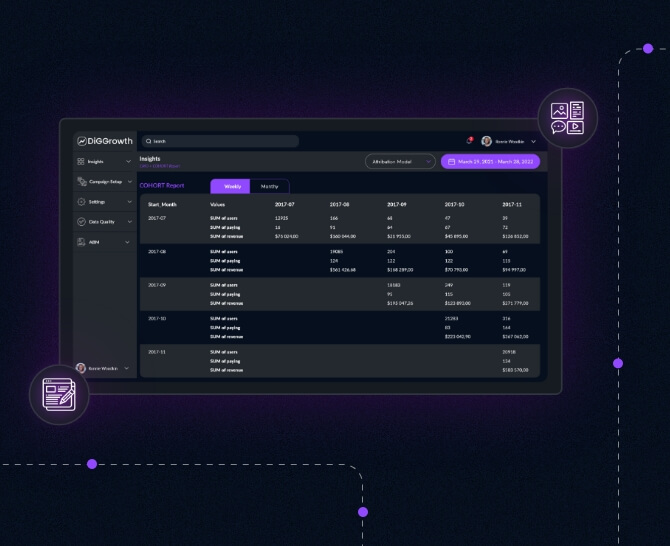
Unlock the Power Of Cohort Analysis To Track Marketing Spend & Boost Revenue
Customer loyalty is fleeting and retaining them is an uphill battle. With cohort analysis, marketers can track & analyze customer behavior over time, by grouping them into segments based on shared characteristics so as to devise sure-fire retention strategies. In this blog post, we have covered everything you need to know about cohort analysis.
Cohort analysis is a powerful tool for marketers to understand customer behavior and optimize their marketing efforts. In today’s fast-paced and competitive business environment, B2B marketers need to stay on top of their game to achieve success. One way to do this is by tracking marketing spend with cohort analysis.
In this blog post, we will discuss the importance of cohort analysis for B2B marketers and how it can help them track their marketing spend effectively. We will also provide step-by-step instructions on how to perform a cohort analysis for tracking marketing spend and share some best practices to optimize your analysis.
What is Cohort Analysis?
Cohort analysis is a technique that allows marketers to track and analyze customer behavior over time. It involves grouping customers into segments based on a shared characteristic, such as their signup date, first purchase date, or location, and tracking how they behave over time. By doing so, marketers can gain insights into customer retention, engagement, and overall lifetime value.
There are three types of cohort analysis that marketers can use:
- Time-based cohort analysis:
- Behavior-based cohort analysis:
- Size-based cohort analysis:
This method involves grouping customers based on the time they signed up or made their first purchase. For example, you could group all customers who signed up in January 2021 and track their behavior over the next 12 months.
This method involves grouping customers based on their behavior, such as the products they purchase, the pages they visit, or the actions they take on your website or app.
This method involves grouping customers based on their company size, such as the number of employees or revenue. For example, you could group all customers with 50-100 employees and track their behavior over time.
The Importance of Tracking Marketing Spend
Tracking marketing spend is essential for B2B marketers to measure the effectiveness of their campaigns and optimize their budget allocation. By tracking marketing spend, marketers can understand which channels are driving the most conversions and revenue, and adjust their strategy accordingly. However, tracking marketing spend can be challenging, especially for B2B companies with complex sales cycles and multiple touchpoints. But cohort analysis solves that.
Benefits of Tracking Marketing Spend with Cohort Analysis
Cohort analysis lets you ask more specific, targeted questions and make informed product decisions that help you to reduce churn and significantly increase revenue. Here are some benefits you can expect to see if you decide to take the cohort analysis route:
- Understand Customer Behavior Over Time:
- Identify Trends and Patterns:
- Measure the ROI of Marketing Campaigns:
Cohort analysis allows marketers to track customer behavior over time, which is crucial for understanding the impact of marketing campaigns on customer engagement and retention.
Cohort analysis can reveal trends and patterns in customer behavior that are not visible in other types of analysis. For example, it can show how the behavior of customers who signed up in January differs from those who signed up in February.
By tracking customer behavior over time, cohort analysis can help marketers measure the ROI of their marketing campaigns and optimize their budget allocation towards initiatives that drive more conversions and revenue.
Real-Life Examples of How Cohort Analysis Can Help Track Marketing Spend
Cohort analysis is actually one of the most popular methods for data analytics because it’s not confined to any one industry or area of focus. Take a look at some real-world examples of how cohort analysis has worked wonders for brands that we hear about every other day.
- Dropbox
- Airbnb
- HubSpot
- Starbucks
Dropbox is a cloud storage and file-sharing platform. The company used cohort analysis to track customer behavior and optimize its referral program. Dropbox found that customers who were referred by existing users had higher retention rates and were more likely to become paying customers. The company optimized its referral program by offering incentives to existing users who referred new customers, resulting in a significant increase in referrals and revenue.
Airbnb is an online marketplace for short-term rental accommodations. The company used cohort analysis to track customer behavior and optimize its marketing spend. Airbnb found that customers who booked their first stay through a referral had higher retention rates and were more likely to become repeat customers. The company optimized its referral program by targeting customers who were most likely to refer others and offering incentives to encourage them to do so.
HubSpot is a marketing automation platform that provides tools for inbound marketing, sales, and customer service. The company used cohort analysis to track customer behavior and optimize its pricing strategy. HubSpot found that customers who subscribed to its most expensive plan had higher retention rates and were more likely to upgrade to even more expensive plans over time. The company optimized its pricing strategy by offering more features and benefits to customers who subscribed to its most expensive plan, resulting in increased revenue per customer.
Starbucks is a multinational chain of coffeehouses. The company used cohort analysis to track customer behavior and optimize its loyalty program. Starbucks found that customers who enrolled in its loyalty program had higher retention rates and were more likely to become repeat customers. The company optimized its loyalty program by offering personalized rewards and incentives to customers based on their purchase history and preferences, resulting in increased customer loyalty and revenue.
These real-life examples show how cohort analysis can be used to track marketing spend and improve marketing strategies for businesses across different industries. By analyzing customer behavior over time, businesses can identify trends and patterns that can be used to optimize acquisition and retention strategies, improve pricing and loyalty programs, and ultimately drive more revenue for the business.
How to Perform Cohort Analysis for Tracking Marketing Spend
Performing a cohort analysis for tracking marketing spend involves the following steps:
Step 1: Define Your Cohorts
The first step in tracking marketing spend with cohort analysis is to define your cohorts. A cohort is a group of customers who share a common characteristic, such as the month they signed up for your product or service, the marketing campaign that brought them in, or their location.
Defining your cohorts is important because it allows you to segment your customer base and analyze customer behavior over time for each segment. This can help you identify patterns and trends in customer behavior that you can use to optimize your marketing efforts and drive more conversions and revenue.
To define your cohorts, start by identifying the characteristics that are most relevant to your business goals and marketing strategy. Some common characteristics to consider include:
- Acquisition channel – the marketing channel (email, social media, paid search, etc) that brought the customer to your website or product
- Signup date – the month, quarter, or year that the customer signed up for your product or service
- Plan type – the kind of pricing plan that the customer is subscribed to (basic, premium, enterprise, etc)
- Location – the geographic region (city, state, country, etc) that the customer is located in
Once you have identified the characteristics that are most relevant to your business, use this information to segment your customer base into cohorts. You can do this manually using a spreadsheet or database, or you can use an analytics tool to automate the process.
Step 2: Track Customer Behavior Over Time
Once you have defined your cohorts, you can start tracking customer behavior over time for each segment. This involves tracking key metrics such as revenue, customer lifetime value, and retention rate for each cohort in each time period (months, quarters, or years).
Tracking customer behavior over time is important because it allows you to identify trends and patterns in customer behavior that can help you optimize your marketing efforts and improve your customer retention and acquisition rates.
To track customer behavior over time, start by setting up a tracking system to capture data on key metrics for each cohort in each time period. This could involve setting up a database, using a customer analytics tool, or manually tracking data in a spreadsheet.
Next, calculate the metrics that you want to track for each cohort in each time period. For example, if you want to track revenue, you would calculate the total revenue generated by each cohort in each time period.
Repeat this process for each metric that you want to track. Once you have calculated the metrics for each cohort in each time period, you can use this data to identify trends and patterns in customer behavior over time.
Step 3: Analyze Metrics for Each Cohort
Once you have tracked customer behavior over time for each cohort, you can start analyzing the data to identify trends and patterns in customer behavior. This involves calculating metrics for each cohort and comparing the metrics across different time periods to identify changes in customer behavior.
To analyze metrics for each cohort, start by calculating the metric that you want to track for each cohort in each time period. For example, if you want to track revenue, you would calculate the total revenue generated by each cohort in each time period.
Next, compare the metrics for each cohort across different time periods to identify changes in customer behavior. For example, you might compare the revenue generated by each cohort in the first month after signup to the revenue generated by each cohort in the second month after signup.
Repeat this process for each metric that you want to track. Once you have analyzed the metrics for each cohort, you can use this data to identify trends and patterns in customer behavior over time.
Step 4: Create a Cohort Analysis Table
Once you have calculated the metrics for each cohort, it can be helpful to create a cohort analysis table to understand the data and identify trends and patterns easily.
To create a cohort analysis chart, start by selecting the metrics you want to track and the time periods you want to analyze. Then, create a table that shows the metrics for each cohort in each time period.
Step 5: Use Cohort Analysis to Optimize Your Marketing Strategy
Once you have created a cohort analysis chart and identified trends and patterns in customer behavior, you can use this data to optimize your marketing strategy and drive more conversions and revenue.
Some ways to use cohort analysis to optimize your marketing strategy include:
- Identify high-value cohorts:
- Optimize your acquisition strategy:
- Improve customer retention:
Use cohort analysis to identify cohorts that generate the most revenue or have the highest customer lifetime value. Then, focus your marketing efforts on these cohorts to drive more conversions and revenue.
Use cohort analysis to identify the acquisition channels that are driving the most valuable customers. Then, focus your marketing spend on these channels to drive more conversions and revenue.
Use cohort analysis to identify cohorts that have low retention rates. Then, develop strategies to improve retention for these cohorts, such as offering targeted promotions or improving the user experience.
Data Requirements for Performing a Cohort Analysis
To perform a cohort analysis for tracking marketing spend, there are certain data requirements that need to be met. These include:
- Customer Identification:
- Relevant Metrics:
- Data Collection:
- Time Period:
Cohorts are created based on specific customer attributes such as the date of first purchase, location, or demographic data. Therefore, it is crucial to have a system in place that accurately identifies and tracks individual customers throughout their journey with the company.
To track the effectiveness of marketing campaigns, you need to define the right set of metrics to analyze. Some common metrics for cohort analysis include customer lifetime value, retention rates, and revenue per user.
To perform a cohort analysis, you need to collect data for each cohort over a set period. This data should be consistent and accurate to ensure that your analysis is reliable.
The time period for a cohort analysis is an important consideration, as it determines the length of time for which you will track each cohort’s behavior. You can choose a time period based on the frequency of customer interactions with your company, such as monthly or quarterly.
Tools and Techniques for Performing a Cohort Analysis for Tracking Marketing Spend
There are several tools and techniques that B2B marketers can use to perform a cohort analysis for tracking marketing spend. These include:
- Spreadsheet Software:
- Business Intelligence Tools:
- Segmentation Techniques:
- Funnel Analysis:
- A/B Testing:
Spreadsheet software like Microsoft Excel or Google Sheets can be used to create and organize data for a cohort analysis. These programs offer various functions and tools for data analysis, including pivot tables and charts.
Business intelligence tools like Tableau or Power BI can also be used to perform cohort analysis. These tools offer more advanced data analysis capabilities, including data visualization, predictive analytics, and machine learning.
Segmentation techniques can be used to create different cohorts based on specific customer attributes. This can be done manually or with the help of machine learning algorithms.
Funnel analysis is another technique that can be used to analyze the customer journey and identify points of friction. By tracking customer behavior through different stages of the funnel, you can optimize your marketing spend and improve conversion rates.
A/B testing is a technique that involves testing different versions of marketing campaigns on different cohorts to identify the most effective approach. This can be done using various tools, such as email marketing software or landing page builders.
Best Practices to Use Cohort Analysis for Tracking Marketing Spend
If there’s anything every business has learned in the last decade is that customer loyalty is fleeting and retention is an uphill battle. While cohort analysis takes you a few steps closer to creating a solid customer retention strategy, if not done right, it will end up being an exercise in futility.
Here are a few best practices to keep in mind when using cohort analysis to track marketing spend.
- Use a consistent time period:
- Use a large enough sample size:
- Focus on the right metrics:
- Use visualization tools:
- Regularly update your analysis:
Use the same time period for each cohort to ensure that you are comparing apples to apples, not oranges.
Ensure that each cohort has a large enough sample size to produce meaningful insights.
Choose metrics that are relevant to your business goals and align with your marketing strategy.
Use visualization tools like charts and graphs to make the data more accessible and easier to interpret.
Regularly update your cohort analysis to reflect changes in customer behavior and the effectiveness of your marketing campaigns.
Understanding Cohort Analysis
Analysis
Cohort analysis is a valuable tool that allows businesses to gain deeper insights into their customer behavior over time. By dividing customers into groups based on their shared characteristics or actions, businesses can track and analyze the behavior of these cohorts individually.
There are different types of cohort analysis that businesses can employ, each serving its own purpose. Time-based cohort analysis groups customers based on the time of their first purchase or at the start of their customer journey. Behavior-based cohort analysis groups customers based on specific actions they have taken, such as signing up for a newsletter or making a recurring purchase.
The benefits of conducting cohort analysis are numerous. It helps businesses understand their customer retention rates, identify patterns in customer behavior, determine the effectiveness of marketing campaigns, and uncover opportunities for improvement.
Data
Accurate cohort analysis requires the use of appropriate data. Businesses need to gather data such as customer demographics, purchase history, and engagement metrics to conduct cohort analysis effectively.
Collecting and organizing data for cohort analysis can be a complex task. It is important to ensure data accuracy by maintaining consistent tracking methods and using reliable data sources. Additionally, businesses need to invest in effective data management systems to organize and access the necessary data for analysis.
However, businesses may encounter data limitations and challenges when conducting cohort analysis. Some data may be incomplete or inconsistent, making it difficult to draw meaningful insights. It is crucial for businesses to address these challenges through data validation techniques and by utilizing statistical methods to fill in missing data.
Implementing Cohort Analysis in Business
- Businesses
- Customer Behavio
- User Analytics
Examples of businesses that can benefit from cohort analysis
How different industries can utilize cohort analysis
Real-life success stories of businesses using cohort analysis effectively
Understanding customer behavior through cohort analysis
Identifying patterns and trends in customer behavior
Using cohort analysis to improve customer satisfaction and loyalty
Leveraging user analytics to enhance cohort analysis
Tracking user behavior and engagement over time
Strategies for utilizing cohort analysis to optimize user experience
Advanced Applications of Cohort Analysis
A. Marketing Analytics
Utilizing cohort analysis to measure marketing effectiveness: Cohort analysis can help businesses understand the impact of their marketing campaigns by comparing the behavior and engagement of different cohorts over time.
Tracking customer acquisition and retention through cohorts: Cohort analysis allows businesses to track the effectiveness of their customer acquisition efforts and identify trends in customer retention.
Personalization and targeting strategies using cohort analysis: By analyzing cohorts, businesses can identify specific customer segments and tailor their marketing messages to improve personalization and targeting.
B. Retention and Churn Analysis
- Predicting customer retention and churn rates
- Identifying factors influencing customer retention
Cohort analysis can help businesses predict customer retention and churn rates by analyzing the behavior and characteristics of different cohorts.
By analyzing cohorts, businesses can pinpoint the factors that contribute to customer retention and develop strategies to improve retention rates.
Using cohort analysis for improved customer retention strategies: Cohort analysis can provide insights that help businesses develop targeted and effective customer retention strategies.
C. Growth Metrics and Business Intelligence
Measuring business growth using cohort analysis metrics: Cohort analysis can help businesses measure and track their growth by analyzing key metrics across different cohorts.
Incorporating cohort analysis into business intelligence processes: By incorporating cohort analysis into business intelligence processes, businesses can gain deeper insights into customer behavior and make more informed decisions.
Leveraging cohort analysis to identify growth opportunities: Cohort analysis can uncover opportunities for business growth by identifying successful acquisition and retention strategies that can be replicated across cohorts.
Conclusion
In today’s competitive B2B marketing landscape, tracking marketing spend is more important than ever. Cohort analysis is definitely a powerful way to help marketers understand customer behavior over time and optimize their marketing efforts to drive more conversions and revenue.
By following the steps outlined in this blog post and adopting best practices for cohort analysis, B2B marketers can gain valuable insights into their customer base and make data-driven decisions that will help them achieve their business goals.
This can be done manually or you could explore and leverage an intelligent AI-driven, no-code marketing analytics platform like DiGGrowth to streamline your marketing data and truly unlock the power of cohort analysis. To find out how DiGGrowth works in the real environment, get a 1:1 demo.
Want to Talk About All Things Cohort Analysis? Get in Touch With Us!
Wherever you may be in your cohort analysis journey, we would love to pitch in. Just write to us at info@diggrowth.com and we’ll take it from there.
Become a Marketer
DiGGrowth helps B2B marketers do more with less and increase marketing ROI by 30%
Get DemoAdditional Resources
15 Rules of Sales Analytics for Cleaning the Pipeline: Unearth Gold, Leave Behind Fool’s Gold Outline
As a sales manager, you already know that...
Read full post postThe OpenAI Shake-Up: Navigating Success with DiGGrowth’s Hybrid Approach
Artificial intelligence is undoubtedly a game-changer for businesses...
Read full post postEnhancing Lead Nurturing with Revenue Attribution Turning Leads into Sales
In a digital-first world, the competition has touched...
Read full post postFrequently Asked Questions
Cohort analysis is a technique that allows marketers to track and analyze customer behavior over time by grouping customers into segments based on a shared characteristic, such as signup date, first purchase date, or location. It helps in gaining insights into customer retention, engagement, and overall lifetime value.
The three types of cohort analysis are time-based cohort analysis, behavior-based cohort analysis, and size-based cohort analysis. Time-based cohort analysis groups customers based on the time they signed up or made their first purchase. Behavior-based cohort analysis groups customers based on their actions and behavior, while size-based cohort analysis groups customers based on their company size.
Tracking marketing spend is crucial for B2B marketers to measure the effectiveness of their campaigns and optimize their budget allocation. It helps them understand which channels drive the most conversions and revenue, enabling them to adjust their strategy accordingly.
By using cohort analysis to track marketing spend, marketers can:
Understand customer behavior over time, aiding in assessing the impact of marketing campaigns on customer engagement and retention.
Identify trends and patterns in customer behavior that are not visible through other types of analysis.
Measure the return on investment (ROI) of marketing campaigns and optimize budget allocation for initiatives driving more conversions and revenue.
Certainly! Here are some real-life examples:
Dropbox used cohort analysis to optimize its referral program, resulting in increased referrals and revenue.
Airbnb employed cohort analysis to enhance its marketing spend by targeting customers most likely to become repeat customers.
HubSpot utilized cohort analysis to optimize its pricing strategy, increasing revenue per customer.
Starbucks employed cohort analysis to improve its loyalty program, resulting in increased customer loyalty and revenue.
 Manreet Khara
Manreet Khara 

